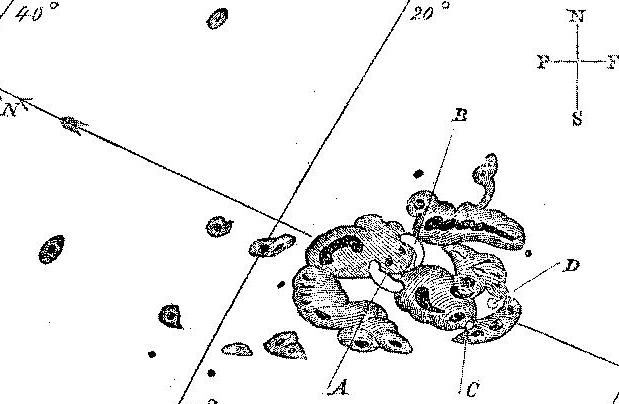
Great Moments in the History of Solar Physics (3)
1859-1931
Return to earlier Great Moments
1859: First observation of a solar flare
On 1 September 1859, the amateur astronomer Richard C. Carrington (1826-1875) was engaged in his daily monitoring of sunspots, when he noticed two rapidly brightening patches of light near the middle of a sunspot group he was studying (indicated by A and B on the drawing below). In the following minutes the patches dimmed again while moving with respect to the active region, finally disappearing at positions C and D. This unusual event was also independently observed by R. Hodgson (1804-1872), another British astronomer.

Reproduction of a drawing by R.C. Carrington, showing the location of the flare he observed while making a drawing of an active region. Reproduced from his 1860 paper in Monthly Notices of the Royal Astronomical Society (vol. 20, p. 13).
This serendipitous observation represents the first clear description of a solar flare, corresponding to a sudden and intense heating of solar atmospheric plasma caused by reconnection of magnetic fields. What Carrington observed would today be called a two-ribbon flare. Only the largest flares are bright enough to be seen in visible light. They are readily seen in X-rays, however (see slide 15 of the HAO slide set). An earlier, plausible observational report of a white light flare has been found in the (unpublished) notebooks of the English scientist and amateur astronomer Stephen Gray (1666-1736), who on 27 December 1705 observed what he described as a ``flash of lightning'' near a sunspot.
Both Carrington and Hodgson noted that magnetic monitoring instruments registered strong disturbances at about the same time, but it is not possible to tell for sure whether these were due to the flare they actually saw. It is more likely that they were caused by other generalized solar disturbances of which the flare was but one manifestation.
References and further readings:
Carrington, R.C. 1860, Monthly Notices of the Royal Astronomical Society, 20, p. 13. Lang, K.R. 2000, The Sun from Space, Springer, chap. 6
| Chronological menu | Biographical index | Index of images |
--------------------------------------------------------------------------------
1859: The chemical composition of the Sun
In the late 1850s the chemist Robert Wilhelm Bunsen (1811-1899) and theoretical physicist Gustav Kirchhoff (1824-1887), both at Heidelberg, took on the issue of spectral line identification pretty much where Fraunhofer had left it some 40 years earlier. By simultaneous observations of the solar spectrum and laboratory flame spectra, they showed that (bright) emission lines in heated gases coincide with (dark) absorption lines seen when observing white light shining through the same cool gas. This established the empirical basis needed for the identification of the dark lines seen in the solar spectrum. By careful comparison with emission lines seen in the laboratory for various pure gases, Kirchhoff could demonstrate the existence in the Sun of a large number of chemical elements, mostly metals, also present on Earth. Hydrogen was identified spectroscopically in 1862 by A. Ångström (1814-1874), but it is only much later, in the 1920's, that Hydrogen was recognized as the most abundant solar constituent.
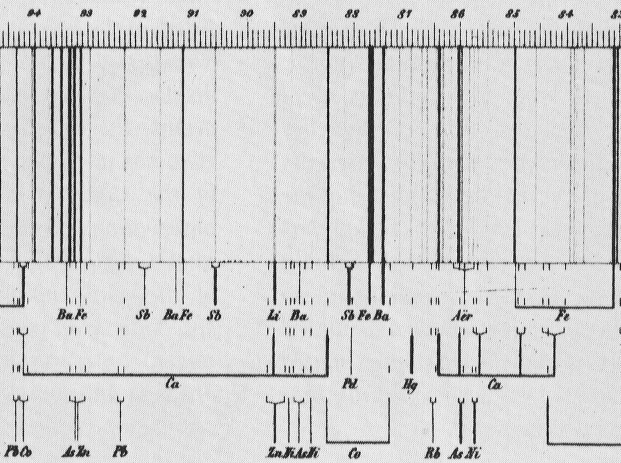
Reproduction of part of the map of the solar spectrum published in 1863 by Kirchhoff, showing the identification of a large number of spectral lines with various chemical elements. Note numerous clear matches for Iron (Fe).
Following this and other groundbreaking work by David Brewster (1781-1868) and Ångström, spectroscopy continued to progress throughout the second half of the eighteenth century. In the solar context, some of the most active and innovative observers were J. Norman Lockyer (1836-1920) Jules Janssen (1824-1907), Hermann Carl Vogel (1841-1907), William Huggins (1824-1910), Angelo Secchi (1818-1878), Charles Young (1834-1908), and Samuel Langley (1834-1906). Even at that time, spectroscopy was still an empirical science without a sound physical basis, as quantum mechanics lay half a century in the future.
References and further readings:
Meadows, A.J. 1984, The Origins of Astrophysics, in The General History of Astronomy, vol. 4A, ed. O. Gingerich, Cambridge University Press, pps. 3-15.
| Chronological menu | Biographical index | Index of images |
--------------------------------------------------------------------------------
1860: First observations of a coronal mass ejection
The total solar eclipse of 18 July 1860 was probably the most thoroughly observed eclipse up to that time. The six drawings are a sample of drawings produced at that time which include depictions of a peculiar feature in the SW (lower right) portion of the corona. Based on comparison with modern coronal observations, it is quite likely that these represent the first record of a Coronal Mass Ejection in progress.
Click on the above to view full size diagrams
Drawings of the 1860 eclipse by G. Tempel (top left), von Feilitzsch (top center), F.A. Oom (top right), E.W. Murray (bottom left), F. Galton (bottom center), and C. von Wallenberg (bottom right). Reproduced from Ranyard, C.A 1879, Mem. Roy. Astron. Soc., 41, 520, chap. 44.
Today coronal mass ejections are known to represent one of the more energetic -and geoeffective- manifestation of solar activity, with up to 10 billion tons of material being ejected into interplanetary space at speeds reaching up to 1000 kilometer per second. For more detail on CMEs see slide 13 and slide 14 of the HAO slide set.
References and further readings:
Eddy, J.A. 1974, A Nineteenth-century Coronal Transient, in Astronomy and Astrophysics, 34, 235-240.
| Chronological menu | Biographical index | Index of images |
--------------------------------------------------------------------------------
1881: The solar constant, again
By the second half of the nineteenth century, after various solar observing expedition to mountaintops, it was becoming increasingly clear that the Earth's atmosphere absorbs a significant portion of the sun's luminosity. Consequently, attempts at determining the solar constant were moved to the highest practical altitudes.
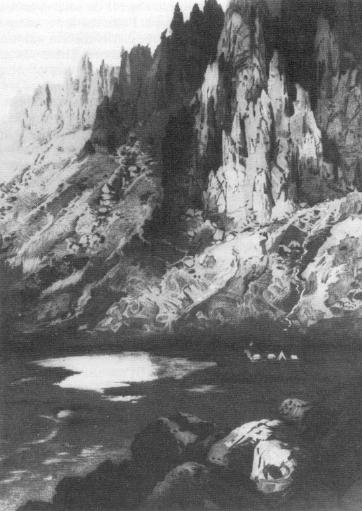
Langley's base camp on California's Mt Whitney, July 1881. Some of Langley's instruments failed to arrive or arrived damaged, with the crucial spectral bolometer back in working order only by the end of August. The expedition was cut short on 8 September due to worsening observing conditions caused by the breakout of a series of wildfires elsewhere in California a few days earlier. Nonetheless, valuable data was collected. Reproduced from: Eddy, J.A. 1990, J. Hist. Astron., 21, p. 115.
The American scientist Samuel Langley (1834-1906) carried out the most elaborate attempt at determining the solar constant at the time, during an expedition to Mt Whitney, California, in July 1881. Using his recently invented bolometer (an instrument based on the varying electrical resistivity of metals with temperature), as well as other instruments, Langley carried out measurements at different wavelengths and at different altitudes, demonstrating the strong variation with wavelength of the absorption by Earth's atmosphere. However, the solar constant value he calculated at the time, 2903 Watt per square meters, is nearly a factor of two larger than the modern value (1367 W/m2), something apparently due to errors in the data reduction procedure, since Langley's later assistant Charles Abbot (1872-1973) obtained 1465 W/m2 with the original Mt Whitney data.
References and further readings:
Hufbauer, K. 1991, Exploring the Sun, The Johns Hopkins University Press.
Eddy, J.A. 1990, Journal for the History of Astronomy, 21, p. 115.
Foukal, P.V. 1990, Solar Astrophysics, John Wiley and Sons.
| Chronological menu | Biographical index | Index of images |
--------------------------------------------------------------------------------
1908: The magnetic nature of sunspots
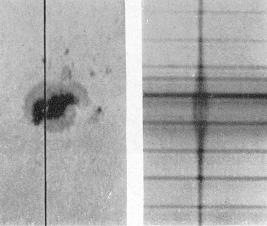
The magnetically-induced Zeeman splitting in the spectrum of a sunspot. Reproduced from the 1919 paper by G.E. Hale, F. Ellerman, S.B. Nicholson, and A.H. Joy (in The Astrophysical Journal, vol. 49, pps. 153-178).
The study of sunspots and their 11-year cycle was finally put on a firm physical footing by the epoch-making work of George Ellery Hale (1868-1938) and collaborators, in the opening decades of the twentieth century. In 1907-1908, by measuring the Zeeman splitting in magnetically sensitive lines in the spectra of sunspots and detecting the polarization of the split spectral components, Hale provided the first unambiguous and quantitative demonstration that sunspots are the seats of strong magnetic fields (see also slide 4 and slide 5 of the HAO slide set The Sun: a Pictorial Introduction). Not only was this the first detection of a magnetic field outside the Earth, but the inferred magnetic field strength, 3000 Gauss, turned out over a thousand times greater than the Earth's own magnetic field. It was subsequently realized that the pressure provided by such strong magnetic field would also lead naturally to the lower temperatures observed within the sunspots, as compared to the photosphere.
References and further readings:
Hale, G.E. 1908, On the probable existence of a magnetic field in sunspots, The Astrophysical Journal, 28, pps. 315-343,
Stix, M. 1989, The Sun, Springer.
| Chronological menu | Biographical index | Index of images |
--------------------------------------------------------------------------------
1919: The Sun's magnetic cycle
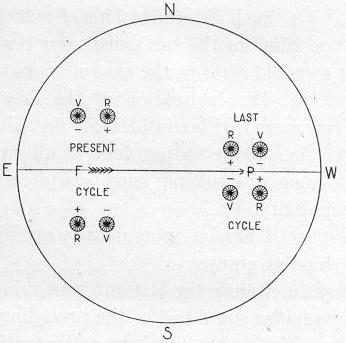 yhs
yhs
A diagram taken from the 1919 paper by G.E. Hale, F. Ellerman, S.B. Nicholson, and A.H. Joy (in The Astrophysical Journal, vol. 49, pps. 153-178), illustrating what is now known as Hale's polarity laws.. This presented solid evidence for the existence of a well-organized large-scale magnetic field in the solar interior, which cyclically changes polarity approximately every 11 years.
In the decade following his groundbreaking discovery of sunspot magnetic fields, George Ellery Hale (1868-1938) and his collaborators went on to show that large sunspots pairs almost always (1) show the same magnetic polarity pattern in each solar hemisphere, (2) show opposite polarity patterns between the North and South solar hemispheres, and (3) these polarity patterns are reversed from one sunspot cycle to the next, indicating that the physical magnetic cycle has a period of twice the sunspot cycle period. These empirical observations have stood the test of time and are since known as Hale's polarity Laws. Their physical origin is now now known to originate with the operation of a large scale hydromagnetic dynamo within the solar interior, although the details of the process are far from adequately understood. Because the sun's dynamo generated magnetic field is ultimately responsible for all manifestations of solar activity (flares, coronal mass ejections, etc.), to this day solar dynamo modeling remains a very active area of research in solar physics.
References and further readings:
Hale, G.E., Ellerman, F., Nicholson, S.B., and Joy, A.H. 1919, The Astrophysical Journal, 49, pps. 153-178,
Stix, M. 1989, The Sun, Springer.
| Chronological menu | Biographical index | Index of images |
--------------------------------------------------------------------------------
1931: The Coronagraph
Much of the remarkable progress made in understanding the Sun's outer atmosphere had been made through the use of observations carried out at times of total solar eclipses. The relative rarity of such eclipses, the cost and logistical difficulties of travelling to often remote location to observe then, the short duration of totality, as well as the frustrating vaguaries of weather, motivated the search for a way to observe the corona at will and in full daylight. This was finally achieved in 1931 by the French solar physicist Bernard Lyot (1897-1952), who first designed an instrument now known as the coronagraph.

Lyot's first coronagraph design. The occulting disk is at B, and the diaphragm and screen at D, E are needed to block stray light arising from diffraction at the primary lens and diaphragm A. Reproduced from L'Astronomie, 66 (1952) (Fig. 113, p. 269).
A coronagraph is nothing more than a telescope equipped with an occulting disk sized in such a way as to block out the solar disk. Although this may sound trivial, it turns out to be extremely difficult to achieve the needed accurate optical alignment and mechanical stability, without which stray light makes the viewing of the faint corona all but impossible. Lyot also managed to secure the first full daylight photographs of the corona. His success motivated other to replicate and modify his design, the most succesful of these followers being Max Waldmeier at the ETH/Zürich, and Donald H. Menzel (1901-1976) at Harvard College Observatory.
References and further readings:
D'Azambuja, L. 1952, L'oeuvre de Bernard Lyot, L'Astronomie, 66, 265-277.
Hufbauer, K. 1991, Exploring the Sun, The Johns Hopkins University Press.
| Chronological menu | Biographical index | Index of images |
--------------------------------------------------------------------------------
Did you find factual errors in any of the above documents? If so, we really want to know! please e-mail paulchar@ncar.ucar.edu.
--------------------------------------------------------------------------------
Further General Readings
Historical:
Boas, M. 1962, The Scientific Renaissance 1450-1630, Harper & Row [Dover reprint available].
Crowe, M.J. 1990, Theories of the World from Antiquity to the Copernican Revolution, Dover.
Hall, A.R. 1963, From Galileo to Newton 1630-1720, Harper & Row [1981 Dover reprint].
Hoskin, M. 1997 (ed.), The Cambridge illustrated History of Astronomy, Cambridge: Cambridge University Press.
Hufbauer, K. 1991, Exploring the Sun, The Johns Hopkins University Press.
Meadows, A.J. 1970, Early Solar Physics, Pergamon Press.
Moore, P. 1974, Watchers of the Stars, Putnam.
Pannekoek, A. 1961, A History of Astronomy, New York: John Wiley Interscience.
Solar Physics, Non-Technical:
Cambridge Encyclopedia of the Sun
Solar Physics, Textbooks and Technical:
Foukal, P.V. 1990, Solar Astrophysics, John Wiley and Sons.
Lang, K.R. 2000, The Sun from Space, Springer.
Stix, M. 1989, The Sun, Springer.
--------------------------------------------------------------------------------
Other web sites:
Institute and Museum of History of Science, Florence
--------------------------------------------------------------------------------
Return to Earlier Great Moments
--------------------------------------------------------------------------------
Did you find factual errors in any of the above documents? If so, we really want to know! please e-mail paulchar@astro.umontreal.ca
--------------------------------------------------------------------------------
-Written by paulchar@astro.umontreal.ca
-Last revised 15 December 2000 by paulchar@astro.umontreal.ca